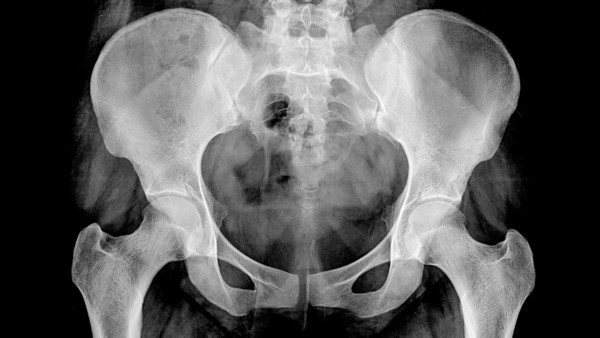Hip Arthritis X-Ray Not Associated with Pain?
I love studies that question our belief systems in orthopedics, and this new one is a doozy. Several years ago, orthopedic guidelines shifted from requiring a knee or hip MRI to recommend a knee or hip replacement to just requiring X-rays. Now, a new study questions whether that’s a smart idea. Basically, it didn’t find an association between a positive hip arthritis X-ray and hip pain.
Arthritis and Imaging

Xray Computer/Shutterstock
Many studies I’ve covered over the years also show that MRI findings simply aren’t a very accurate predictor of hip or knee pain. Most physicians, for example, who see a hole in the cartilage on MRI in a patient with knee pain would automatically associate the two. However, one study showed that patients with a hole in their knee cartilage didn’t have any greater chance of having pain as those without a hole in their cartilage.
Lumbar stenosis is another MRI finding that many doctors will find significant when a patient has hip pain. If an MRI shows compressed nerves due to arthritis (stenosis), then the patient must have pain. Yet a recent study concluded no relationship between the finding of spinal stenosis on MRI and pain. Another study found MRI worthless in diagnosing spinal stenosis as the cause of pain.
Hip arthroscopies are also being done for tears of the labrum and hip impingement found on MRI and associated with the patient’s hip pain. Here again, the MRI is an inaccurate indicator for diagnosing the cause of hip pain as many patients with no pain can show signs of tears and impingement on their MRI. And many patients who undergo surgery for these conditions due to their pain still complain of hip pain.
Another common surgery we see being done based no MRI findings is meniscus-tear repair. If you are a regular reader of this blog, you know how opposed I am to most meniscus surgery. Meniscus tears seen on MRI are no more significant than wrinkles or gray hair. Many of us develop them as we age, and just as many people who don’t have knee pain have meniscus tears. So meniscus tears on MRI plus knee pain should not result in knee surgery.
This lack of association between knee pain and MRI findings is nothing new. I’ve been sharing these knee surgery and MRI studies with you since way back in 2008, when the New England Journal published a study showing 60% of people with meniscus tears present on MRI did not actually have any knee pain.
So if MRIs already weren’t cutting it, why are we now diagnosing pain with nothing more than a simple X-ray?
Today’s Common Practice of a Hip Arthritis X-Ray and Then Surgery
If a patient walks in with a hip X-ray that shows moderate hip arthritis and reports hip pain, you can bet that after a cursory exam (usually performed by a physician extender), it’s time to replace the hip. Ten years ago, these decisions were made using MRIs, but some government committee decided at some point that all that was needed was a hip arthritis X-ray. Is this a good idea? Not according to a recent study.
The New Research on Hip X-Rays and Pain
This new study used data from the Framingham osteoarthritis study, a government-funded investigation into the nature of imaging and arthritis. Looking at 946 patient X-rays of hips, only 15.6% of the patients with frequent hip pain showed evidence of hip arthritis. In addition, only 20.7% of the hips with hip arthritis were frequently painful. In a much larger Osteoarthritis Initiative study (n=4,366), only 9.1% of hips in patients with frequent pain showed evidence of hip arthritis, and only 23.8% of hips with hip arthritis on X-ray were frequently painful. The authors concluded, “Hip pain was not present in many hips with radiographic osteoarthritis, and many hips with pain did not show radiographic hip osteoarthritis.”
The upshot? At the end of the day, this study doesn’t support the idea that we should be using a hip arthritis X-ray and the presence of hip pain as the major determinant of which hips need replacing. It’s consistent with many other studies showing that arthritis on X-ray or MRI and pain are two different things. Now we just need to reeducate an army of orthopedic surgeons who are likely amputating hips that don’t hurt that they need to look more closely at this issue. How can you prevent this from happening to you? Make sure you get a numbing shot in your hip under X-ray guidance and that this resolves your pain before you have someone replace your hip. Better yet, make sure you see if you’re a candidate for stem cells in that hip before someone cuts it off!

If you have questions or comments about this blog post, please email us at [email protected]
NOTE: This blog post provides general information to help the reader better understand regenerative medicine, musculoskeletal health, and related subjects. All content provided in this blog, website, or any linked materials, including text, graphics, images, patient profiles, outcomes, and information, are not intended and should not be considered or used as a substitute for medical advice, diagnosis, or treatment. Please always consult with a professional and certified healthcare provider to discuss if a treatment is right for you.
